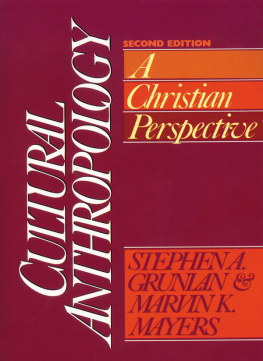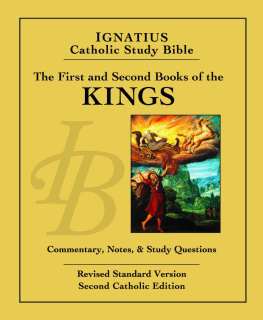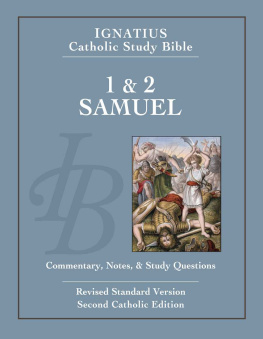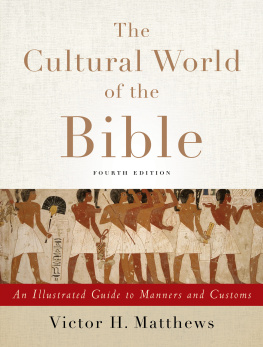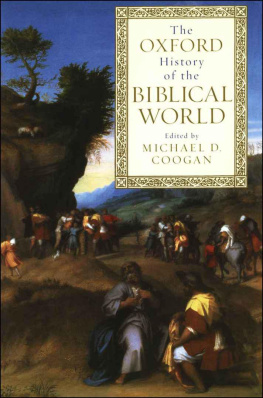Contents
In a highly accessible style yet with deep and wide scholarship, John Pilch, an international authority on the biblical social world, leads us, like a trustworthy tour guide, through the highways and byways of the ancient world. Thanks to his work, the Bible becomes alive to us again as Gods Word in human words. I most strongly recommend this handbook to both scholars and general readers.
PETER C. PHAN
Georgetown University
An award-winning predecessor volume by John Pilch (The Cultural Dictionary of the Bible) proved enormously useful for my undergraduate biblical-studies classroom. This new compilation of articles once again demonstrates Pilchs rich knowledge of biblical culture and provides readers with many satisfying insights. A Cultural Handbook to the Bible will well serve students, clergy, and university-level teachers.
DOUGLAS E. OAKMAN
Pacific Lutheran University
Once more Pilch has given us what we have come to expect from him thorough knowledge from Middle Eastern and Mediterranean cultures giving new and unexpected insights into the texts of the Bible. Short essays on a wide range of topics provide answers to the curious Bible reader, and bibliographies give students tools to pursue their own explorations into the fascinating world of the Bible. This is a book to enjoy and learn from!
HALVOR MOXNES
University of Oslo
A Cultural Handbook to the Bible
John J. Pilch
WILLIAM B. EERDMANS PUBLISHING COMPANY
GRAND RAPIDS, MICHIGAN / CAMBRIDGE, U.K.
2012 John J. Pilch
All rights reserved
Published 2012 by
Wm. B. Eerdmans Publishing Co.
2140 Oak Industrial Drive N.E., Grand Rapids, Michigan 49505 /
P.O. Box 163, Cambridge CB3 9PU U.K.
18 17 16 15 14 13 12 7 6 5 4 3 2 1
Library of Congress Cataloging-in-Publication Data
Pilch, John J.
A cultural handbook to the Bible / John J. Pilch.
p. cm.
Includes bibliographical references and indexes.
ISBN 978-0-8028-6720-9 (pbk.: alk. paper)
ISBN 978-1-4674-3666-3 (epub)
1. Bible Handbooks, manuals, etc. I. Title.
BS417.P54 2012
220.9'5 dc23
2012007734
www.eerdmans.com
For my colleagues and friends in:
The Context Group: A Project on the Bible in Its Socio-Cultural Context;
The Social Sciences and New Testament Interpretation Task Force at the Catholic Biblical Association of America; and
The Social Scientific Criticism of the New Testament Section at the Society of Biblical Literature
who have inspired, encouraged, and nurtured my research and publications over more than four decades
with heartfelt appreciation and gratitude
From 1993 to 2006, I wrote a bimonthly article in The Bible Today (Collegeville, MN: The Liturgical Press) under the heading A Window into the Biblical World. The aim of these articles was to show how insights from Middle Eastern culture drawn from the social sciences (Cultural Anthropology, Middle Eastern Anthropology, Medical Anthropology, and others) helped to situate the Bible in its proper cultural context. For example, the salt statements of Jesus recorded in the Gospels (Matt 5:13; Mark 9:49-50; Luke 12:49; 14:34-35) have nothing to do with seasoning or preserving foods. Rather, they reflect the use of salt in the Middle East to facilitate the burning of the common fuel camel and donkey dung in the ovens. The articles that appeared from 1993 to 1997 were published in The Cultural Dictionary of the Bible (Liturgical Press, 1999). In 2000 this book won an award from the Catholic Press Association and was subsequently translated into Italian (Il Sapore della Parola, ncora, 2001) and Polish (Sownik Kultury Biblijnej, Edycja w. Pawa, 2004).
In this sequel to that book, I have collected the articles published in that journal from 1998 to 2006 and arranged them thematically under eight headings. Some articles could probably fit under more than one heading, so the arrangement is somewhat arbitrary. However, this is not a book one would read from beginning to end. It is not a book to be read at one sitting. Most readers will quite likely consult the Table of Contents and select a topic that catches attention at the moment.
A special feature of this book and its predecessor is that each article applies insights from the social sciences to the interpretation of biblical passages, topics, and themes. The references listed under Further Reading are primarily the social-science resources consulted and secondarily biblical resources that have applied these social-science insights to select segments or books of the Bible. For example, the Further Resources for the part on the Family lists the anthropological resources I consulted in writing each of those chapters (e.g., Broude, Francoeur, and Shapiro) and biblical resources which have applied such insights in interpreting their topics (e.g., Campbell, Malina, and Malina and Rohrbaugh). With this book, readers should be able to become acquainted with social-scientific sources and methods, and also be able to see how biblical scholars utilizing these resources are able to produce fresh, Middle Eastern, culturally plausible interpretations of that Middle Eastern document known as the Bible.
The challenge that remains, then, is how to translate those Middle Eastern understandings to other nonMiddle Eastern cultures, situations, and problems. For example, if marriage, adultery, and rape in the Bible do not mean what they mean in Western and other cultures, what can a Bible reader draw from this information? How can a Bible reader bridge the gap between that culture and her or his own? Again, in the Further Readings on Family, I list two very useful resources, books by Augsburger, and Stewart and Bennett. These two books can serve as basic sources for anyone who wants to address the challenge that the Bible hurls at teachers, preachers, and readers. Perhaps this present book and its predecessor can assist.
For an Index of References to the Roman Lectionary, see my web site: http://mysite.verizon.net/vzewdxtw/drjohnjpilchwebpage/id67.html.
| Feast of St. Francis of Assisi | JOHN J. PILCH |
| October 4, 2011 | The Odyssey Programs |
| Johns Hopkins University |
In our lifetime, human beings have put various satellites into orbit, become travelers to the moon, and sent exploratory probes deep into outer space. Our knowledge of the universe has expanded dramatically. Yet when contemporary Christians speak about heaven (the sky) and earth and hell, they neglect to notice that these concepts as currently understood carry centuries of outdated intellectual baggage. A close examination of these and related concepts as they appear in the Bible will give readers a fresh appreciation of how our ancestors in the faith understood their cosmos, and what they had in mind when they used these terms.
In the worldview of traditional holy men and holy women (often called shamans by anthropologists) the Tree of Life is a key way of understanding the cosmos. (This concept appears to have nothing in common with the mythological biblical Tree of Life in Gen. 2:4b3:24, which is a source of life.) In traditional shamanic reflection, the universe is like a gigantic, cosmic tree. The analogy is vegetative rather than animal. The change of seasons and the change of skyscapes and landscapes are rather like the cycle of a tree than like the behavior of animals. From the flat-earth perspective of these traditional holy men and women, the universe is like a unique tree, the Tree of Life, that stands at the very center of the universe. Its roots contain the lower world, which is the habitat of power animals and the abode of dead souls and/or helper spirits. Its trunk contains the middle world, the spiritual counterpart or parallel to the world in which human beings live. This middle world contains the spirit or essence of all things. It is the real world behind the visible world. It is sometimes called alternate reality, though that more properly describes the upper world. The branches of the Tree of Life contain everything that exists inside and outside our galaxy. Shamans, or holy men and/or women in each culture, take spirit journeys in trance in order to visit these three worlds (Pilch 2011: 48-60). Ezekiel (e.g., Ezek. 3:14-15) and John (e.g., Rev. 4:1-2) are two holy men in the biblical tradition who visited one or another of these worlds (Malina and Pilch 2000).



